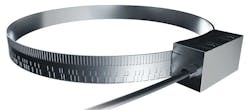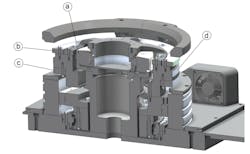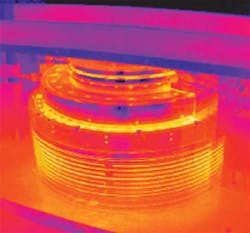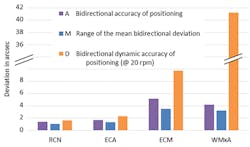Evaluating Angle Encoders’ Effects on Motors
Why are there so many different angle encoders on the market? Why do they use different scanning and measuring methods? And which one should a designer choose?
To answer those questions, engineers at Heidenhain set up a torque motor commanded by a CNC controller hooked up to four different angle encoders to see how they differ. The four absolute angle encoders included a sealed optical encoder for rotary tables and swivel heads; a modular optical encoder with a steel scale drum for wide-axis rotary tables and swivel heads; a contamination-tolerant modular magnetic encoder; and a compact inductive scale-tape encoder.
The controller simulated positioning tasks for each angle encoder while technicians analyzed how signal quality affects dynamic performance and how the measuring principle affects accuracy. They also examined how using data from the motor, encoder and sensor could improve process reliability.
Signal Quality
In direct drive motors, the encoder’s signal quality plays a critical role in the amount of electrical current noise, which affects the motor’s dynamic performance and possible power dissipation. The noise is a retroactive effect of interpolation errors and affects the dynamic performance of an axis. Interpolation errors, in turn, are rapid changes in the position value that cause errors in calculating the speed calculation. These errors lead to more current noise. To avoid instability in the drive system, the increase in noise must be counteracted by reducing the loop gain, which will in turn lower the motor’s dynamic performance.
Noise also affects a motor’s thermal behavior. Low noise levels translate into lower power dissipation and motor temperatures. High noise levels, on the other hand, increases the motor’s power dissipation and significantly raise its temperature.
Comparing the noise from different encoders reveals their behavioral differences. Optical encoders cause low, steady noise, whereas magnetic and inductive encoders cause higher, much more heterogeneous noise, even with a low-pass filter. This makes optical encoders the best choice for getting the most out of a motor’s performance potential and getting the best-surface quality.
Actual Versus Desired Position
Whether or not the actual position of a rotary table coincides with the desired position can be evaluated based on statistical measurement of positioning accuracy in accordance with ISO 230-2. This calls for five clockwise and five counterclockwise revolutions of the rotary table, with 12 measurements taken at 30-deg. steps over each revolution.
Key metrics for evaluating encoders are Parameter A (the bidirectional positional accuracy) and Parameter M (the range of the mean bidirectional positional deviation). Parameter A is comparable to the accuracy of an angle encoder and Parameter M to the graduation accuracy, each taking into account the error from the application.
To evaluate the contouring accuracy at a given maximum speed, the evaluation went beyond ISO 230-2 criteria and added dynamic accuracy of positioning (designated by the letter D). As in ISO 230-2, measurements are once again taken over five clockwise and five counterclockwise revolutions of the rotary table. This time, however, the measurements are taken at a scanning rate of 5 kHz and a speed of 20 rpm.
Measuring the dynamic positioning accuracy at the contouring accuracy uncovers high deviations for inductive angle encoders. (Contouring accuracy refers to the changes in accuracy measured at speed by comparing desired position to actual position.) The deviation is a byproduct of inductive scanning that causes accuracy to vary with speed. In contrast, optical encoders demonstrate hardly any deviation between desired and actual positions. The magnetic encoder showed mid-level performance without extreme deviation.
Motor Protection
Torque motors provide high performance in a compact device. But overheating is a risk if current distribution in the windings becomes asymmetric during certain machining operations, causing a surge in temperature of a single winding. Sending sensor data on thermal behavior around the motor to the controller protects the motor, as well as increases the reliability and efficiency of machining processes.
The sensor box used in the evaluation monitors all three motor windings, providing the temperature data for immediate use. The box is installed next to the motor and between the encoder and controller. If the motor’s thermal model is already known, as is the case with the torque motor, the sensor box will rapidly detect sudden temperature rises and preventing damage to the motor windings and protecting the motor from overheating.
Choosing the right encoder and using the various data available from the machining process are important for reliability, stability and accuracy of machining processes. Knowing the characteristics of different encoders lets designers and developers choose the most suitable encoder for an application. After all, choosing the right encoder isn’t just about dynamic performance and accuracy; designers and developers must also take design-related factors such as the shaft diameter and mounting into account, not to mention cost-effectiveness.











